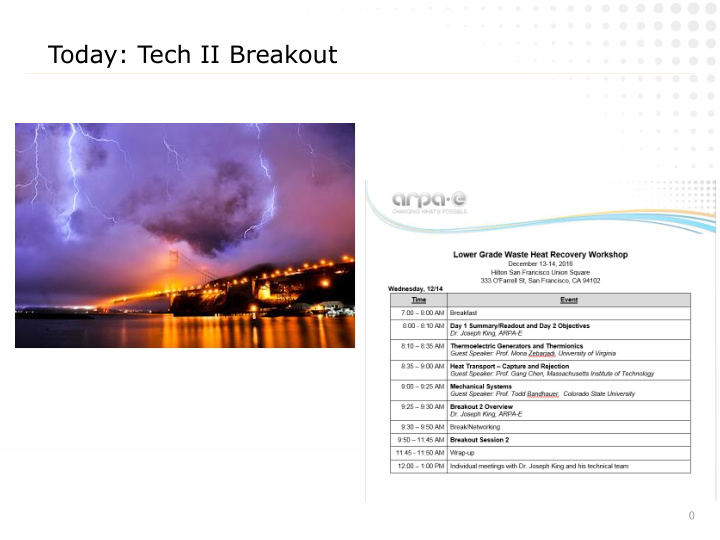



Today: Tech II Breakout 0
Breakout Session Goals - Identify and Capture 1. What is the current state-of-the-art? 2. What are the three biggest performance limitations in the field? 3. If solved, what would be the biggest break though or quantum leap forward for this technology? 4. Are there challenging but reasonable approaches to address the limitations? 5. What is the biggest opportunity/application for this technology were the limitations to be surmounted? 26
Preview: Seed Questions Mechanical Systems: Q 1 : Are there any new energy conversion cycles? Q 2 : Are there advantages to expanding the types of working fluid selection to improve availability, costs, GHG impact, corrosion reduction, etc .? Q 3 : Are there novel, yet untried, devices ( e.g. compressors, turbines or expanders) which might lead to improved efficiency at low cost if developed? Q 4 : Are there any new mechanical systems other than ORC for transportation applications that could lead to significant size/weight reductions at a competitive cost? Q 5 : Are there potential opportunities for weight reduction and efficient heat capture using highly conductive polymers? Q 6 : What would it take to obtain efficiencies above 50%? Are there untried designs which might achieve this? 5
Seed Questions By Area Thermophotovoltaics: - High temperature device: 700 – 1500 + K - Higher temperatures yield higher power (∞T 4 ) and efficiency - Near field requires sub-100nm separation - PV cell bandgap energy between 0.4 – 0.6 eV ( e.g. In 1-x Ga x As) - 8 - 12% efficient Q 1 : What are the challenges to achieving a near-field emitter-PV cell separation of <100nm? Are there feasible designs possible which might achieve this spacing? Q 2 : Alternatively, is there a way to loosen the emitter cell spacing requirements for efficiency? Are there topological and/or material systems which might enable this? Q 3 : What would need to be true to get a system energy efficiency above 20 – 25%? Would it be possible to do so below 400-500 o C? Q 4 : Can a far-field blackbody limited device ever yield a high conversion efficiency? 5
Seed Questions By Area Thermionics: - Cathode: High Heat Distortion Temp. (900 o C-2,000 +o C) - Maximum cathode-anode Δ work function - Narrow Cathode – anode spacing (< 10 µm) - Surface sensitization ( e.g . Cs) - 6 – 10% efficient Q 1 : What would need to be true to operate efficiently below 600 – 700 o C? Q 2 : Are there stable alloys that results in a lower work function than any of the individual elements work functions: - e.g. eutectic materials? Q 3 : What would need to be true to get a system energy efficiency above 20-25%? Q 3 : Is there a topology approach to design a lower cathode work function w/wo sensitization? 5
Seed Questions: Thermoelectrics Thermoelectrics: (“Phonon Glass - Electric Crystal”) - High electrical conductivity (ion mobility) - Low thermal conductivity (limited phonon mobility) - Brittle materials ( e.g . highly doped semiconductors) - Thermal shock tolerance - 6 – 10% efficient Q 1 : Are there semiconductor classes/structures predicted to be effective (ZT>2; η ≥ 10 -12%) but are unexplored? Q 2 : What can be done with module designs which would make the system more resilient ( e.g . to thermal cycling/shock) and/or at lower cost (<$1/W)? Q 3 : What would need to be true to get a system energy efficiency above 20 – 25% operating below 400-500 o C? Q 4 : The Lorenz ration between electrical and thermal conductivity is a property that varies only over a factor of two range. Are there any material classes or material engineering strategies which can exhibit a Lorenz number below 2.44 x 10 -8 W/(Ohm-K)? 5
Recommend
More recommend